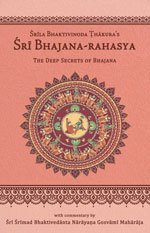Bhajana-Rahasya
by Srila Bhaktivinoda Thakura Mahasaya | 2010 | 123,965 words
The Bhajana-rahasya Text 33, English translation, including commentary (vritti). The Bhajana-rahasya is a compilation of verses describing the mercy of the eight pairs of names (Yugala-nama) of the Maha-mantra. This is text 33 belonging to the chapter “Prathama-yama-sadhana (Nishanta-bhajana–shraddha)” representing the last six dandas of the night: approximately 3.30 a.m.–6.00 a.m.
Text 33
Hari-bhakti-vilāsa (17.129) states:
मनः संहरणं शौचं मौनं मन्त्रार्थ-चिन्तनम्
अव्यग्रत्वम् अनिर्वेदो जप-सम्पत्ति-हेतवःmanaḥ saṃharaṇaṃ śaucaṃ maunaṃ mantrārtha-cintanam
avyagratvam anirvedo japa-sampatti-hetavaḥWhile chanting, one should be one-pointed and give up talking about mundane topics. With a pure heart, one should think about the meaning of the holy name, and be steadfast and patient in ones chanting and remembrance of the holy name.
जप काले मनके एकाग्र-भावे लह
चित्ते शुद्ध थाक, वृथा कथा नाहि कहjapa kāle manake ekāgra-bhāve laha
citte śuddha thāka, vṛthā kathā nāhi kahaनामार्थ चिन्तह सदा धैर्याश्रय कर
नामेते आदर करि’ कृष्ण-नाम स्मरnāmārtha cintaha sadā dhairyāśraya kara
nāmete ādara kari’ kṛṣṇa-nāma smara
Commentary: Bhajana-rahasya-vṛtti:
The method for one to perfect the chanting of his mantras, both harināma and gāyatrī, is described in this Text.
Manaḥ saṃharaṇam–While chanting the holy name, one should fix the mind on the desired name of the Lord and remember pastimes connected with that name. The mind of the conditioned living entity wanders to different subject matters, and therefore one should stay in the association of sādhus and control the mind through renunciation and practice.
Śauca–It is necessary for the sādhaka to maintain a standard of external cleanliness by bathing and so forth, and to keep his mind pure through internal cleanliness. He can do this by bringing the six enemies, headed by lust, under control. In this way, his mind will not be attracted to anything other than Kṛṣṇa.
Mauna–To speak only bhagavat-kathā and reject talk unrelated to Kṛṣṇa is known as mauna (silence). One should not talk about anything mundane while chanting.
Avyagratā–The restless nature of the unsteady mind is called vyagratā. One should chant with avyagratā, a peaceful and undisturbed mind.
Anirveda–One should not become discouraged by moving slowly in one’s endeavour to attain the desired goal; rather, one should chant with patience.
Nāmārtha-cintana–While chanting mantras, the sādhaka should remember Śrī Rādhā-Kṛṣṇa’s pastimes of meeting (milana ) and separation (vipralambha). When he chants his mantras, he should practise in the following five ways:
(1) The sādhaka should know the meaning of the mantra. He should remember the predominating deity of the mantra (the mantradevatā ) and his own specific relationship with that deity.
(2) Nyāsa–“The deity of the mantra is my protector”–this conviction is called nyāsa. It is true that success can be attained by uttering the mantra one time only;nonetheless, the mantra is uttered ten or one-hundred-and-eight times for the pleasure of the mantradevatā. This is also called nyāsa.
(3) Prapatti–“I take shelter of the lotus feet of the mantra-devatā.” This is called prapatti.
(4) Śaraṇāgati–“I am a jīva who is suffering greatly, and therefore I surrender to the deity.” This resolve is śaraṇāgati.
(5) Ātma-nivedana–“Whatever I have belongs to Him; it is not mine. I do not even belong to myself; I am His for Him to enjoy.” This is ātma-nivedana.
If the devotee follows the process comprised of these five limbs, he will quickly attain perfection in chanting his mantras.
